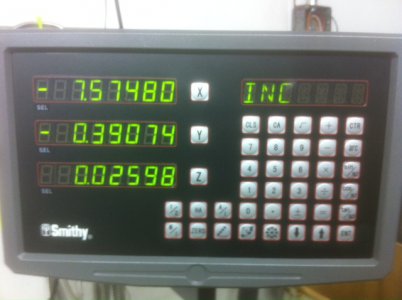Back around the early 1990's I decided to get into Hobby metal workiing. I had been fabricating things and welding them for many years but I decided that a lathe would be an excellent item to add to my complement of tools.
With that in mind, I started looking in my local area, Sacramento, CA, for something made in America. Remember, this was before the advent of eBay and the height of the internet. There was one local machinery seller who handled used equipment. He did indeed have some lathes, some of them were even made in the U.S. Sadly, they and the other Chinese and Taiwanese lathes that he had were obviously totally worn out. I'm talking about dings, dents, cracks, missing parts and grime with obvious wear in the bed area. He wasn't into machine restoration. He would buy machines, put them on the floor at inflated prices and then just stand back. He had nothing in his store for less than $2,000 either, and it wasn't looking good.
After about a year of frustration looking at ads for auctions and considering shpping costs, I looked at an Enco ad. At that time, they still had their brick and mortar stores. The closest one was San Jose, CA. I took my pickup truck and wife and we took a trip to San Jose.
The one I liked the most, mainly since it wasn't too big to fit in the truck, and also because if was in my price range ($2,500 max.) was their 13 X 40" model 110-1340. It came in the crate for $2,300 plus tax out the door. It had the typical complement of accessories like D1-4, 3 jaw and 4 jaw chucks, steady and follow rests, lantern toolpost, back plate, 2 hp single phase motor, etc.
Fortunately, my 1/2 ton Chevy pickup had been fitted with 3/4 ton springs because the crate weighed 1,500 pounds. When they loaded the crate onto the truck, it went down about three inches but we made it home.
So far, it's been a good machine. It has 8 speeds and has done all manner of tasks for me. I ran it all the way up to this year and then finally added a two-axis Sino DRO from CDCO tool Co. This particular lathe is almost identical to the present day Grizzly 13-1/2 X 40" (G4016). They apparently have an additional 1/2" of swing but in all other respects, it appears identical, even up to the design of the controls and the specifications.
Changes I've made other than the DRO were to raise the bed of the lathe 3" on some square steel tubing risers that I fabricated. That enables me more easily to clean out the chips from under the bed. It also made it easier to work with the machine since I found it too low initially. I also added a Phase II QCTP from Enco about a month after I bought the lathe. I had trouble with the lantern toolpost.
I wish I could have found a lathe that was made in the U.S. but it wasn't to be, When I bought my Webb mill in 2009, there was a nice Monarch 10EE in the same warehouse but the broker wanted $4,000 and it was sort of out of the question since I was already hauling the mill home.
Anyway, I can recommend this machine highly. It's done everything I ever needed and nothing has ever broken.
Thanks for listening.
Some pictures.
Before the DRO but after the 3" risers.

3" risers in place.

With DRO.

With that in mind, I started looking in my local area, Sacramento, CA, for something made in America. Remember, this was before the advent of eBay and the height of the internet. There was one local machinery seller who handled used equipment. He did indeed have some lathes, some of them were even made in the U.S. Sadly, they and the other Chinese and Taiwanese lathes that he had were obviously totally worn out. I'm talking about dings, dents, cracks, missing parts and grime with obvious wear in the bed area. He wasn't into machine restoration. He would buy machines, put them on the floor at inflated prices and then just stand back. He had nothing in his store for less than $2,000 either, and it wasn't looking good.
After about a year of frustration looking at ads for auctions and considering shpping costs, I looked at an Enco ad. At that time, they still had their brick and mortar stores. The closest one was San Jose, CA. I took my pickup truck and wife and we took a trip to San Jose.
The one I liked the most, mainly since it wasn't too big to fit in the truck, and also because if was in my price range ($2,500 max.) was their 13 X 40" model 110-1340. It came in the crate for $2,300 plus tax out the door. It had the typical complement of accessories like D1-4, 3 jaw and 4 jaw chucks, steady and follow rests, lantern toolpost, back plate, 2 hp single phase motor, etc.
Fortunately, my 1/2 ton Chevy pickup had been fitted with 3/4 ton springs because the crate weighed 1,500 pounds. When they loaded the crate onto the truck, it went down about three inches but we made it home.
So far, it's been a good machine. It has 8 speeds and has done all manner of tasks for me. I ran it all the way up to this year and then finally added a two-axis Sino DRO from CDCO tool Co. This particular lathe is almost identical to the present day Grizzly 13-1/2 X 40" (G4016). They apparently have an additional 1/2" of swing but in all other respects, it appears identical, even up to the design of the controls and the specifications.
Changes I've made other than the DRO were to raise the bed of the lathe 3" on some square steel tubing risers that I fabricated. That enables me more easily to clean out the chips from under the bed. It also made it easier to work with the machine since I found it too low initially. I also added a Phase II QCTP from Enco about a month after I bought the lathe. I had trouble with the lantern toolpost.
I wish I could have found a lathe that was made in the U.S. but it wasn't to be, When I bought my Webb mill in 2009, there was a nice Monarch 10EE in the same warehouse but the broker wanted $4,000 and it was sort of out of the question since I was already hauling the mill home.
Anyway, I can recommend this machine highly. It's done everything I ever needed and nothing has ever broken.
Thanks for listening.
Some pictures.
Before the DRO but after the 3" risers.

3" risers in place.

With DRO.




